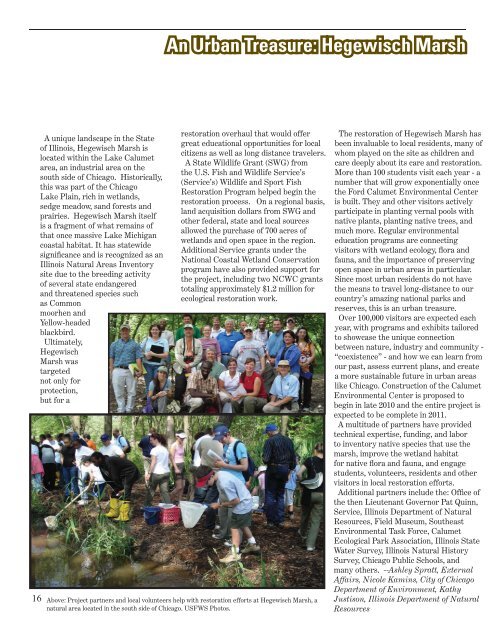February 2010 - U.S. Fish and Wildlife Service
February 2010 - U.S. Fish and Wildlife Service
February 2010 - U.S. Fish and Wildlife Service
You also want an ePaper? Increase the reach of your titles
YUMPU automatically turns print PDFs into web optimized ePapers that Google loves.
16<br />
A unique l<strong>and</strong>scape in the State<br />
of Illinois, Hegewisch Marsh is<br />
located within the Lake Calumet<br />
area, an industrial area on the<br />
south side of Chicago. Historically,<br />
this was part of the Chicago<br />
Lake Plain, rich in wetl<strong>and</strong>s,<br />
sedge meadow, s<strong>and</strong> forests <strong>and</strong><br />
prairies. Hegewisch Marsh itself<br />
is a fragment of what remains of<br />
that once massive Lake Michigan<br />
coastal habitat. It has statewide<br />
signifi cance <strong>and</strong> is recognized as an<br />
Illinois Natural Areas Inventory<br />
site due to the breeding activity<br />
of several state endangered<br />
<strong>and</strong> threatened species such<br />
as Common<br />
moorhen <strong>and</strong><br />
Yellow-headed<br />
blackbird.<br />
Ultimately,<br />
Hegewisch<br />
Marsh was<br />
targeted<br />
not only for<br />
protection,<br />
but for a<br />
An Urban Treasure: Treasure: Hegewisch Marsh<br />
restoration overhaul that would offer<br />
great educational opportunities for local<br />
citizens as well as long distance travelers.<br />
A State <strong>Wildlife</strong> Grant (SWG) from<br />
the U.S. <strong>Fish</strong> <strong>and</strong> <strong>Wildlife</strong> <strong>Service</strong>’s<br />
(<strong>Service</strong>’s) <strong>Wildlife</strong> <strong>and</strong> Sport <strong>Fish</strong><br />
Restoration Program helped begin the<br />
restoration process. On a regional basis,<br />
l<strong>and</strong> acquisition dollars from SWG <strong>and</strong><br />
other federal, state <strong>and</strong> local sources<br />
allowed the purchase of 700 acres of<br />
wetl<strong>and</strong>s <strong>and</strong> open space in the region.<br />
Additional <strong>Service</strong> grants under the<br />
National Coastal Wetl<strong>and</strong> Conservation<br />
program have also provided support for<br />
the project, including two NCWC grants<br />
totaling approximately $1.2 million for<br />
ecological restoration work.<br />
Above: Project partners <strong>and</strong> local volunteers help with restoration efforts at Hegewisch Marsh, a<br />
natural area located in the south side of Chicago. USFWS Photos.<br />
The restoration of Hegewisch Marsh has<br />
been invaluable to local residents, many of<br />
whom played on the site as children <strong>and</strong><br />
care deeply about its care <strong>and</strong> restoration.<br />
More than 100 students visit each year - a<br />
number that will grow exponentially once<br />
the Ford Calumet Environmental Center<br />
is built. They <strong>and</strong> other visitors actively<br />
participate in planting vernal pools with<br />
native plants, planting native trees, <strong>and</strong><br />
much more. Regular environmental<br />
education programs are connecting<br />
visitors with wetl<strong>and</strong> ecology, fl ora <strong>and</strong><br />
fauna, <strong>and</strong> the importance of preserving<br />
open space in urban areas in particular.<br />
Since most urban residents do not have<br />
the means to travel long-distance to our<br />
country’s amazing national parks <strong>and</strong><br />
reserves, this is an urban treasure.<br />
Over 100,000 visitors are expected each<br />
year, with programs <strong>and</strong> exhibits tailored<br />
to showcase the unique connection<br />
between nature, industry <strong>and</strong> community -<br />
“coexistence” - <strong>and</strong> how we can learn from<br />
our past, assess current plans, <strong>and</strong> create<br />
a more sustainable future in urban areas<br />
like Chicago. Construction of the Calumet<br />
Environmental Center is proposed to<br />
begin in late <strong>2010</strong> <strong>and</strong> the entire project is<br />
expected to be complete in 2011.<br />
A multitude of partners have provided<br />
technical expertise, funding, <strong>and</strong> labor<br />
to inventory native species that use the<br />
marsh, improve the wetl<strong>and</strong> habitat<br />
for native fl ora <strong>and</strong> fauna, <strong>and</strong> engage<br />
students, volunteers, residents <strong>and</strong> other<br />
visitors in local restoration efforts.<br />
Additional partners include the: Offi ce of<br />
the then Lieutenant Governor Pat Quinn,<br />
<strong>Service</strong>, Illinois Department of Natural<br />
Resources, Field Museum, Southeast<br />
Environmental Task Force, Calumet<br />
Ecological Park Association, Illinois State<br />
Water Survey, Illinois Natural History<br />
Survey, Chicago Public Schools, <strong>and</strong><br />
many others. --Ashley Spratt, External<br />
Affairs, Nicole Kamins, City of Chicago<br />
Department of Environment, Kathy<br />
Justison, Illinois Department of Natural<br />
Resources

















